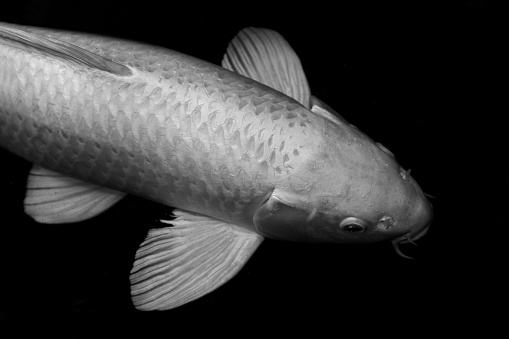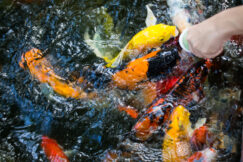The Ghost koi fish has grown in popularity in recent years, although many koi fans do not accept them as authentic koi fish; instead, they are referred to as Ghost carp.
This is because Ghost koi were created when a mirror carp was crossed with a metallic Ogon koi, making them less tamed than other koi.
Whatever you name Ghost koi, its lovely colors, distinctive attributes, and gentle demeanor make them an excellent first fish for novice koi owners.
What exactly is a Ghost Koi?
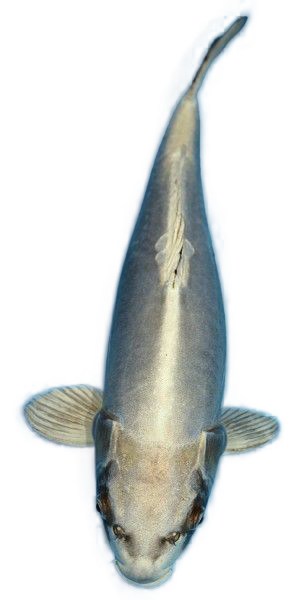
Ghost Koi were created in the 1980s when Koi Carp were crossed with more naturally colored wild carp (mirror or common carp). The ultimate result is fish with many of the characteristics of pure Koi Carp (Nishikigoi), but with dark scales along the back and frequently dark patterns on the face and body.
When Koi farmers stumbled upon such fish in the 1980s, they were killed because they were unsuitable. While Ghost Koi were frequently nearly completely black in the 1980s, modern versions are considerably more colorful, available in both scaled and scale-less (doitsu) kinds, and have become a standard feature in many Koi ponds worldwide.
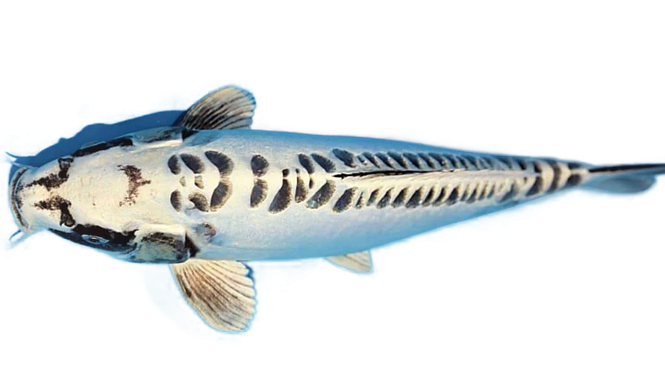
The exquisite examples we see now may be attributed to Koi pioneering countries such as Israel.
Ghost Koi have the same genetic make-up as real Nishikigoi. While the natural Amur carp species has diverged from the Koi Carp in appearance owing to hybridization, they are still the same species and may produce viable progeny.
Aside from color, one of the most noticeable changes is that Ghost Koi are more ravenous eaters than their counterparts.
Coloring

The Ghost koi earned its name from its oblique color. The initial Ghost koi was black in hue, allowing it to blend into the dark depths of a pond with just its metallic scales revealing its location, giving it the appearance of a koi fish ghost.
The majority of the attractiveness of ghost koi comes from their gleaming metallic scales, which lack any visible markings. Since the first Ghost koi were created, they have been bred to have cream, silver, and golden coloration, making them less ghostly but just as beautiful.
Characteristics that are unique
Because Ghost koi are hybrids, they have the greatest qualities of both koi and carp. These koi are less sensitive to infections, making them an excellent choice for new owners who are unable to detect health issues immediately.
Because of their close relationship with Carp, Ghost koi may develop swiftly, which is great news for owners who want giant koi in their pond quickly. Ghost koi are also known to grow bigger than most other koi, reaching weights of up to forty pounds. Despite all of the features Ghost koi gained from their carp father, they retain the beauty and friendliness of a koi.
Attitude
Many people believe that due to their more wild history, Ghost koi are more aggressive than other koi, however ghost koi are just as nice as any other. Ghost koi are extremely food motivated and will rapidly learn to swim to your hands for a mouthful to eat.
These koi are also highly active, and you can constantly find them swimming towards the surface of your pond in search of food. As a result, they will be one of the most apparent fish in your pond.
What’s the distinction between ghost koi and butterfly ghost koi?
The fins of butterfly ghost koi distinguish them from regular ghost koi. Unlike ordinary ghost koi, which have genes that indicate their fins to cease growing after a set length of time, butterfly ghost koi fins continue to develop throughout their lives. As a consequence, some pond owners enjoy the long, flowing fins.
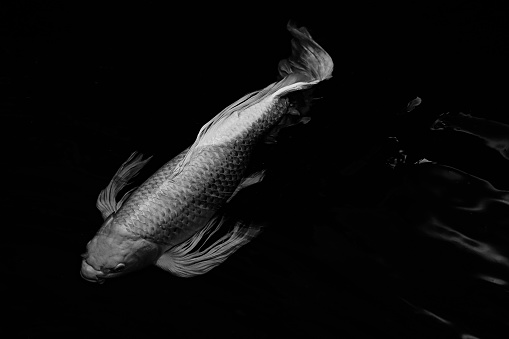
FAQs
How should a Ghost Koi be cared for?
Our top Ghost Koi care recommendations are as follows:
- Feed them well by providing high-quality food (but not too much)
- Keep an eye out for any strange conduct (clamped fins, heavy breathing, flashing etc.)
- Be proactive in dealing with prospective concerns, such as Employ frequent visual examinations to detect them early and use targeted treatments as needed.
- Check your water parameters on a regular basis.
How long do Ghost Koi live?
In terms of lifetime, we should anticipate it to be comparable to that of actual Koi lifespan – normally 30 – 70 years, however there have been reports of Koi in considerably warmer locations living to over 200 years.
How large can Ghost Koi get?
They grow to the same overall size as Koi Carp in our experience, but as previously noted, their ravenous eating habits can force fish to grow considerably larger rapidly.
It’s rather uncommon to see Ghost Koi come up for food first and consume the most in a pond, as this is an innate behavior. Similarly, they will frequently spend their time searching the water’s surface for food, making themselves quite visible and fascinating to watch.
What should I feed my Ghost Koi?
In terms of nutritional requirements, they, like Koi, will eat almost anything but are best fed on sustainable fish diets that encourage fish health, size, and color.
Other than fish food, what should you feed Ghost Koi?
In addition to fish food, you may feed your Ghost koi a number of other foods. What are some of the best things to give your koi besides fish food? However, keep in mind that this dish should only be offered on rare occasions and in limited quantities.
- Prawns
- Shrimp
- Crab shelled
- Feeder fish
- Daphnia
- Cockles
- Worms of all kinds
- Sweet corn
- Oranges
- Lettuce
- Spinach
- Cucumber
- Zucchini
- Other types of leafy greens
- Bread
When can Ghost Koi breed?
Breeding Ghost Koi (or any Koi) might be difficult because they prefer more moderate temperatures to breed in. In order to be successful, the weather must be warm enough.
When the time comes, fish will frequently seek out highly planted sections of the pond (or spawning brushes, if appropriate) – females will disperse eggs, and males will fertilize them.
Koi will frequently swallow the majority of their eggs after spawning, thus it is best to shift eggs to a separate brooding tank/pond after spawning, or else let nature take its course and hope for survival.
Are Ghost Koi tough?
Ghost Koi are quite robust due to their ancestry with wild carp, yet they are susceptible to ALL fish-based parasites. In our experience, Ghost Koi have less health issues and tend to survive better with parasite outbreaks.
This is most likely owing to genetic linkages with robust wild fish, just like pedigree bred dogs have more health concerns than crossbred dogs due to selective breeding pressures.
How much do Ghost Koi cost?
Ghost Koi are frequently significantly less expensive than actual Nishikigoi Koi Carp since they are not classed or recognized as true Koi Carp by fanatical Koi lovers. When compared to a show-winning Kohaku, this is reasonable.
Having said that, they are a terrific addition to any pond, frequently boosting the confidence of other fish in the pond. You definitely get a lot of bang for your money with Ghost Koi, so if you’re looking for something huge, why not try one for your pond?
Do Ghost Koi consume other fish?
Ghost Koi, despite their scary name, are not predators and will seldom consume other fish.
Are ghost koi dangerous to other pond fish?
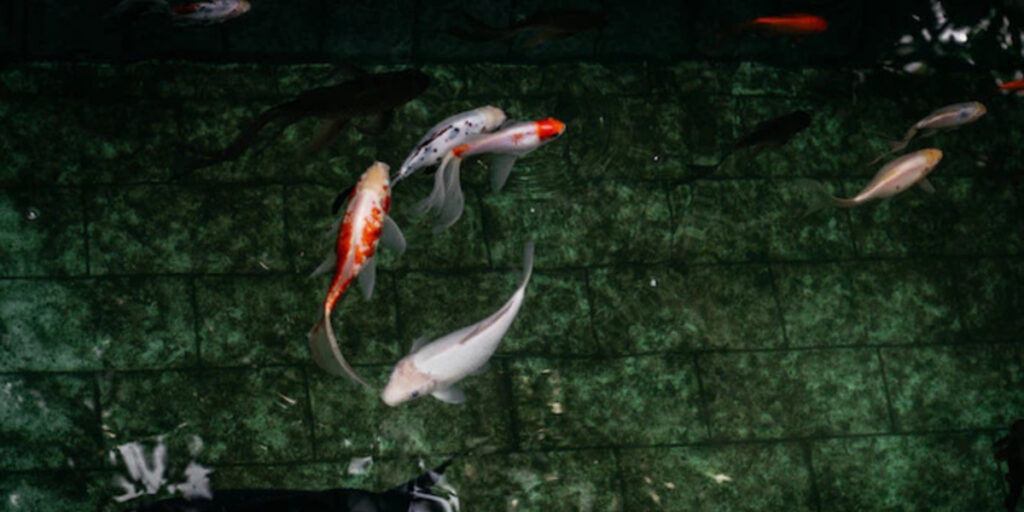
Ghost koi are much like any other koi in terms of friendliness.
Although koi are normally calm and easygoing fish, depending on the conditions, they can be aggressive and disturb other fish.
General temperament, breeding and spawning, lack of room & overstocking, low quality food & nutrition, sickness or injury, heightened stress, poor water quality, and inappropriate pond companions are all variables that can be influenced by koi carp aggressiveness.
How long will they be able to go without food?
Ghost koi carp may go for several days without being fed. Even if they are hungry after 3 or 4 days without food from you, they will not starve.
By day 5, though, be sure you feed them something substantial. They will undoubtedly be hungry at this stage, but they will not expire as a result.
They could even be able to survive for a longer amount of time if the pond they live in has a high level of biological variety. They will be able to search for food if there is enough algae, some little fish, and other plant materials in the pond, as well as insects.
While Ghost koi are unlikely to be able to survive without food for more than 4 or 5 days, they are capable of seeking for it on their own in the pond.
In other words, it’s not a big deal if you skip a feeding now and then; nevertheless, try not to do so on a regular basis.
How can I get my Ghost Koi to grow faster?
Maintaining the right water temperature in the tank or pond, as well as optimal feeding, is the greatest way to guarantee that your Ghost koi fish develops as fast as possible.
Keep the water temperature in your pond between 77 and 80 degrees Fahrenheit if you want your koi to grow swiftly. Because, as previously said, this might boost the feeding rate of ghost carp fish.
Furthermore, feeding your Ghost koi fish a balanced diet and providing lots of food will assure rapid growth.
Are Ghost Carp uncommon?
Simply put, Ghost koi are not uncommon. Despite being a hybrid, Ghost carp are reproductive. They may mate with each other both naturally and artificially.
As a result, it aids in population growth. They have the ability to generate more than 10,000 offspring each breed. They may live in a variety of environments.
Conclusion
Were you shocked by the Ghost koi’s name? If not, what most shocked you about the Ghost koi fish? Do you believe it should be referred to as a Ghost koi or a Ghost carp?
The Ghost koi or carp is an excellent addition to any pond, particularly a new pond. Ghost koi are attractive, amiable, and robust, making them an ideal first koi for a novice koi owner. If you decide to add a Ghost koi to your pond, make sure you have adequate area for it since it will rapidly grow to be one of the largest koi in your pond.

